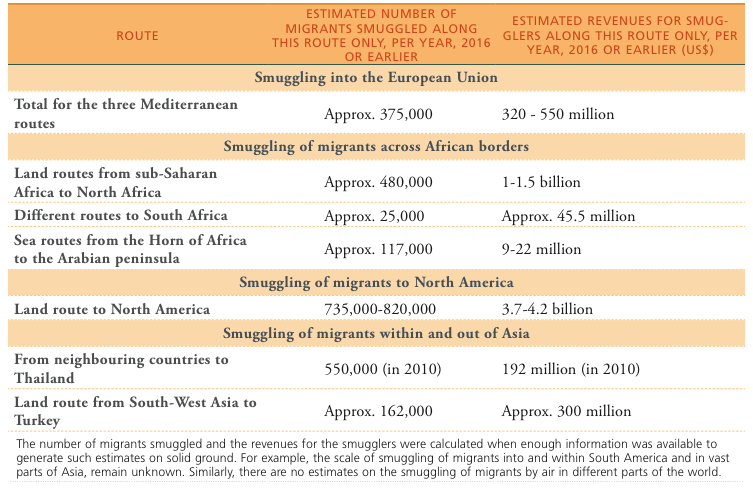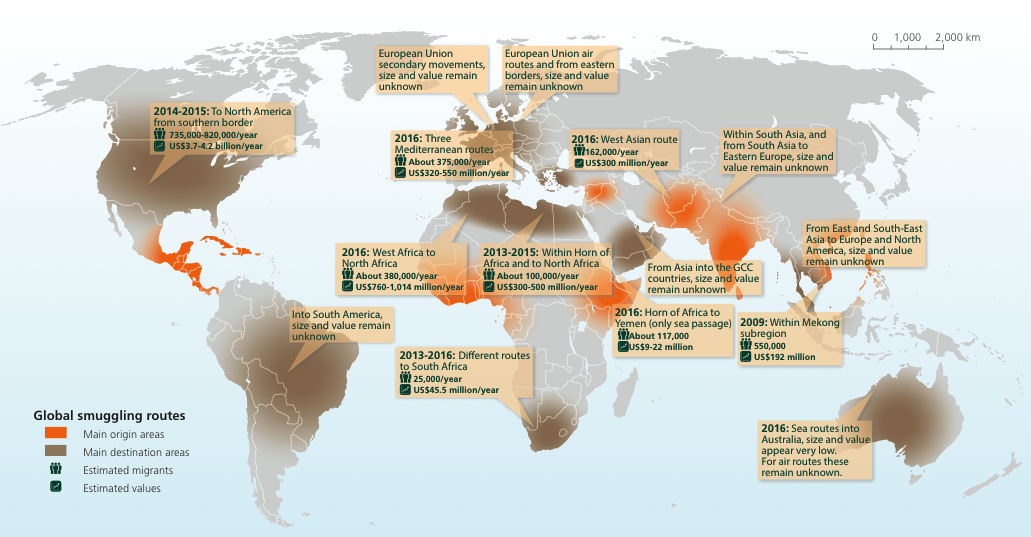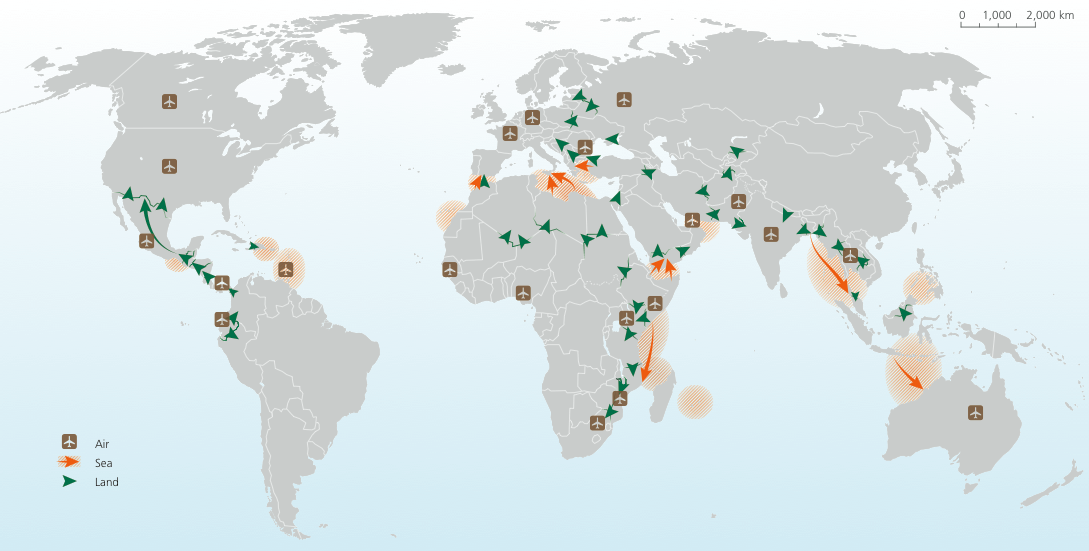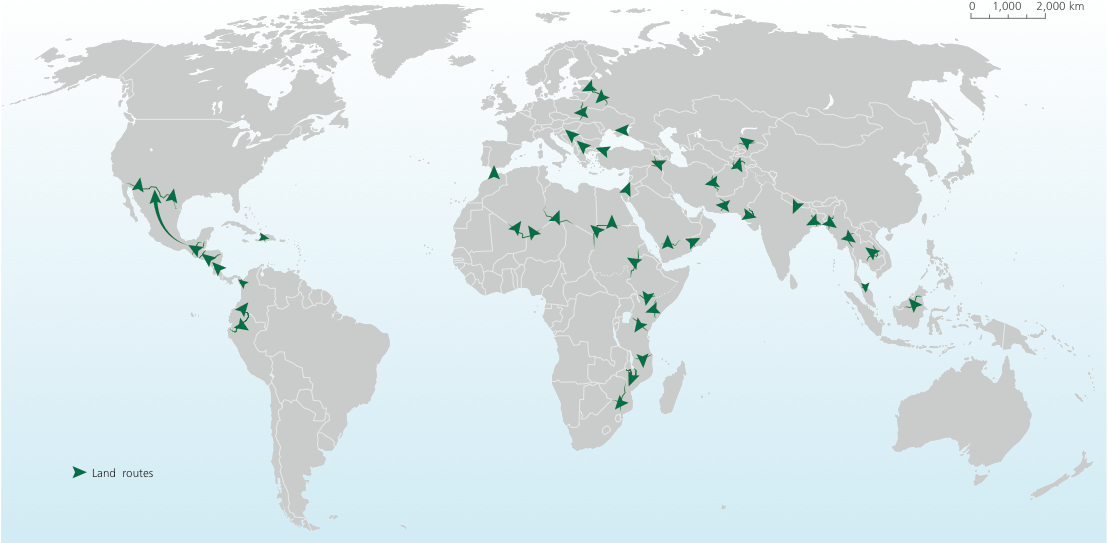Smuggling of migrants is a crime that affects virtually all countries in the world. Some countries are origins of migrants that are further smuggled, others are destinations, or transit areas. Smuggling operations take place across a wide range of countries. There is a myriad of routes used to smuggle migrants, some changing rather quickly. For this study, more than 30 main smuggling routes were identified. They only represent what is known to law enforcement, researchers and other actors who have studied smuggling of migrants in different parts of the world.
Along these routes, UNODC found that a minimum of 2.5 million migrants were smuggled in 2016,m generating a minimum annual income for smugglers of about US$5.5 to 7 billion. For many of the routes, it was not possible to collect sufficient evidence to estimate the number of smuggled migrants or the smuggling income, so these global figures represent minimum values for the magnitude and criminal profits from migrant smuggling.
Estimated magnitude and value of selected smuggling routes

An analysis of the trends for the different smuggling routes shows the volatility of the smuggling routes and the stability of the smuggling hubs. If the demand for facilitating illegal entries and the supply of smuggling services remain the same, the sealing of certain routes does not necessarily change the overall level of migrant smuggling, but may trigger increasing flows along other routes. However, the places where the smuggling activity is organised generally remain stable over time. This is probably linked to the fact that smuggling activities are often rooted in local communities whose livelihoods depend on the income from migrant smuggling and/or are managed by groups which are highly organised and can easily change strategies.
Smuggling of migrants may be a rather simple activity, such as organising the crossing of a lightly controlled border or paying off a border guard. Smuggling may also involve complex schemes, such as organising fake marriages or fictitious employment, counterfeiting travel documents or corrupting senior officials.
Estimated magnitude and value of the major smuggling routes

There is no ‘typical’ smuggler or smuggling operation. Migrant smugglers may organise and oversee a long, com- plicated travel itinerary, a single border crossing close to their place of residence, or anything in between. Moreover, smugglers may be active at the beginning, in the midst of or towards the end of a smuggling trajectory. Sometimes, smugglers offer a range of services, with some clients opting for comprehensive services and others for a limited piece of facilitated movement.
The same is true for migrants. In some cases, migrants travel largely independently, purchasing smuggling services for only certain legs of the route or for some border crossings. Migrants may also stop along the route; some- times to work in order to make money for the rest of their travels. Others buy the entire journey prior to departure and leave most of the route decisions to the smugglers.
Major land, sea and air smuggling transits and destinations

Main emerging characteristics for smuggling routes:
- There are many smuggling routes and methods to reach destinations and myriad alternative border crossing points. Different land and sea passages can be used along the same route.
- Smuggling typically takes place in uncontrolled areas with dangerous circumstances which put migrants at risk. But smuggling also occurs through official border crossings by land or air, using fraudulent documents and corrupt practices.
- Points of departure for smuggling by sea generally require territorial control by smugglers.
- Smugglers adopt different strategies according to the protection policy applied in destination countries and the citizenship of the smuggled migrants in order to maximise the chances for migrants to remain in destination countries. Points of arrival are often selected according to whether migrants seek detection or not.
- In contrast to routes, smuggling hubs tend to be stable over time.
By land, sea or air
Migrant smuggling can be carried out in many ways. Different routes require certain smuggling methods and types of transportation to cross a variety of terrains and borders. Smuggling of migrants may entail arranging for the cross- ing of deserts, mountains, jungles, open sea, rivers and lakes. Smuggling can also happen through official land or air border crossing points, making use of fraudulent documentation. In some cases, particularly when the departure point and intended destination are geographically distant, smugglers may facilitate the crossing of international borders at airports using commercial flights. Most of the smuggling routes described in this study involve the cross- ing of several international borders, and criminals use different methods or a combination of methods to smuggle a person into the desired destination country.
Decisions regarding which border to cross, at what specific location and the method to use depend on a range of factors, including the smugglers’ organisational capacity, the migrants’ economic means and available time, border controls, immigration enforcement and threats connected to the natural environment, to mention some. Within the relevant constraints, the final decision regarding where and how to cross the border is also heavily influenced by the perceived probability of smuggling success.
Migrants originating from the Horn of Africa, for example, may be smuggled to Southern Africa by a long over- land journey that might be shortened by making use of sea passages along the African coasts or across the African Great Lakes. Some may be smuggled into South Africa by flying directly from their country of origin to an airport
at destination, or by landing in neighbouring countries and travelling overland from there.2 Asian migrants may be smuggled into Australia by sea.3 Many Asians also travel overland for parts of this extensive journey. West Africans may be smuggled to North Africa and then cross the land borders into the Spanish cities of Ceuta and Melilla to reach the European Union. Alternatively, they may be smuggled by air, with counterfeited documents, to major international airports in Europe, or they may be smuggled by sea across the Mediterranean to Italy.4 Most smuggling routes involve choices and decisions regarding specific travel itineraries and means of transport.
Major overland smuggling routes and crossings

Smuggling at land borders
Border crossings through land borders (also known as ‘green borders’) may not require sophisticated smuggling activities. Some land borders would seemingly not even require the facilitation by a smuggler, where, for instance, border controls are not heavily enforced. This appears to be the case for some borders between the countries in the Mekong subregion or some parts of Central Asia. Even when tight controls are in place, some land passages may not require smugglers. For example, some people manage to irregularly enter the Spanish cities of Ceuta and Melilla by simply assaulting the border fence in large numbers.
Nevertheless, these are exceptions rather than rules. Crossings of green borders often do require smugglers’ facilitation. Entering into Ceuta and Melilla is also possible by paying a smuggler to provide a counterfeit document or a safe passage hiding in trucks transiting in these cities. The vast majority of the migrants that cross the United States-Mexico land border irregularly do so by using a professional smuggler. Smugglers are active along many African land borders, at the eastern European Union land borders and at some overland border crossings in Central Asia.
Smugglers are needed not only to evade border controls, but often also to increase the probability of safe passage along hazardous overland trails. Particularly dangerous trajectories assessed in this study include the jungles of South-East Asia, deserts in Africa and the Americas, as well as areas with significant risk of encounters with armed and criminal groups in many parts of the world.
Choosing smuggling routes: between land and sea
On some routes, smugglers or migrants can choose land or sea crossings according to a range of factors that influence the chances of taking migrants safely to their destination.
An illustrative example of route displacement due to enhanced enforcement is the crossing of the border between Turkey and Greece along the Eastern Mediterranean route. Smuggling by land from Turkey to Greece was widespread between 2010 and 2012. At the end of 2012, a fence was built along the land border between these two countries. Border controls were also intensified. As a result, since the end of 2012, smuggling routes largely shifted back to the Aegean Sea and to a minor extent to the Turkish-Bulgarian land border.
Similarly, the route leading migrants from the Horn of Africa to Southern Africa largely involves land passages through Kenya, the United Republic of Tanzania and Mozambique. However, in some cases smugglers prefer to avoid the risks connected to such land passages by taking boats leaving from Somalia or the southern coastal towns of Kenya arriving at the southern coasts of Tanzania or even further south, in Mozambique. Another recent example of the use of (in this case, more complex) sea routes as an alternative to a land route is for migrants from the Horn of Africa to cross the Arabian sea to Yemen, and crossing back on to African shores in Sudan, instead of using the more direct land route to Sudan.
Sea or land crossings may appear to be interchangeable. However, smuggling by sea requires better planning and organization. Smugglers need to be able to obtain and manage vessels, their departure, journey and sometimes their return. In addition, people involved in the organization of smuggling by sea may also require access to locations to shelter large number of migrants for weeks before departure. Sometimes smugglers are also selective regarding the profiles of migrants to travel on board different vessels. Smuggling by sea requires specific logistics, access to tools and infrastructure, and the ability to move freely around territories to ensure that boarding and departure are relatively safe.
Currently, the most relevant smuggling passages involving sea crossings are those across the Mediterranean Sea to southern Europe, from the Horn of Africa to the Arabian peninsula and across the Andaman Sea to South-East Asia. Less relevant than in the recent past are sea smuggling routes to Australia from South-East Asia.
Smuggling by air and combinations of different methods
In contrast to crossings overland and by sea, migrant smuggling by air is more expensive but in general safer for migrants. Smugglers may arrange for migrants to board commercial flights connecting international airports. Migrants passing through airports will necessarily face document controls. As a consequence, smuggling by air normally requires a smuggling organization capable of providing migrants with travel documents (false, counterfeit, lookalike, modified or fraudulently obtained) to pass through border control and / or to bribe officials to let them in. Other forms of smuggling by air may involve ad hoc arrangements to grant legal access to the country on fraudulent grounds, such as fictional international conferences or fake marriages. It is difficult to estimate the size of this type of migrant smuggling as it is unknown how many succeed in entering each country.
Many smuggling routes involve more than one method of transportation. Often a migrant is smuggled through a combination of land, sea or air smuggling.
Moreover, some of the travel might also be undertaken regularly. The routes that lead West Africans to Europe, for example, normally involve regular international bus travel from the migrants’ country of origin towards a transit country in the Sahel, followed by smuggling by land into North Africa, and from there, smuggling to Europe by sea. The routes from the Horn of Africa to the Middle East require smuggling by land to Djibouti or Somalia, by sea to Yemen and again by land to other countries of the Arabian peninsula. Similarly, many Afghans traverse large parts of South-West Asia overland, often with facilitation by smugglers, are then smuggled across the sea to Greece along the Eastern Mediterranean route, and then continue overland along the Western Balkans route (often with smugglers).
Routes connecting geographically distant areas, such as Asia and Europe, or much of the transcontinental smuggling into the Americas, often involve at least one passage by air. The routes may then continue by land and / or sea to reach the migrant’s final destination. Different transfer combinations could be individual parts of a pre-planned smuggling itinerary, or a sequel of smuggling passages organised separately in different moments of a long journey.
IMAGE CREDIT: EUROPOL
